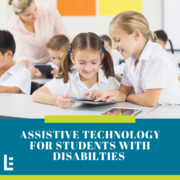Assistive Technology for Students with Disabilities
Assistive technology in special education refers to any sort of device or resource that is used to make learning more accessible to students with disabilities. Assistive technology is not reserved for any one circumstance. There are various types of technologies that can be used to support students with any disability, whether it be a physical, emotional, or mental disability. Read on for suggestions and resources to support students with special needs.
Text to speech
Text to speech, TTS, can be used to support students with various obstacles that might impact learning. The technology scans and modifies print text so that students are provided with audio of the text. TTS resources are especially helpful to students who have difficulty absorbing and/or processing print text. Some conditions might include visual impairment or blindness, ADHD, dyslexia, autism, or other health impairments that impede the ability to read print. Some advanced devices that utilize TTS are portable and can be carried around during the school day to photograph any piece of text. The device will then use its camera image to translate the text to audio that students can save.
Proofreading technology
Assistive technology that helps students become better proofreaders can be beneficial to all students, but especially for those who struggle with executive functioning deficits or attention issues. Proofreading one’s own writing is inherently difficult, especially if it is something that the writer has already read through a few times. This is because we often overlook our errors because we know what we are trying to say, so our eyes fail to recognize a careless mistake. Furthermore, several proofreading systems also utilize TTS software so that students can hear their potential errors aloud.
Electric handouts
For students who may struggle with the physical process of writing and/or lack the cognitive ability to process thoughts and commit those thoughts to paper, digital handouts can be immensely helpful. The key is to allow students to exhibit their ability without the barrier that pencil-to-paper writing might cause. Depending on the students’ needs, teachers might create digital documents that allow students to drag and drop appropriate responses, as opposed to writing them out or drawing lines to match them up. For math items, digital handouts ensure that multi-step math problems remain clear, organized, and aligned properly for students that struggle with the physical aspects of writing.
Low-tech options
While many examples of assistive technology in the classroom involve the use of computers or digital programs, there are various low-tech approaches that can help students with special needs. Many of these suggestions are considered best practices for all learners. Flexible seating, which allows for stools, bean bags, yoga balls, or standing desks help students with ADHD try to refocus during class work. Flex seating can also be used for students who struggle to self-regulate or who depend on movement to expel stress and anxiety. Even simple classroom items and modifications, such as pencil grips, wrist pads for keyboards, slanted table tops, or colored overlays are considered assistive resources. While relatively unsophisticated, these tools can make all the difference for students whose learning is impacted by a disability.




